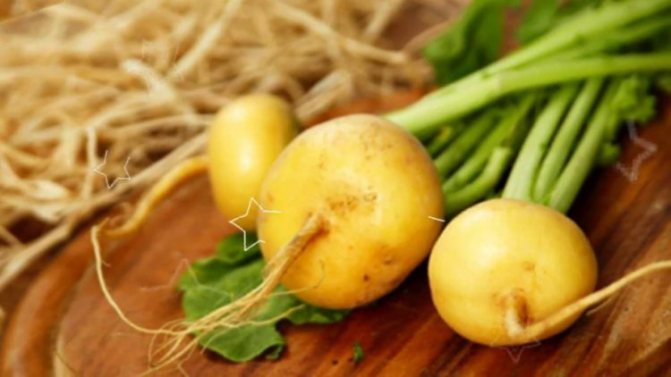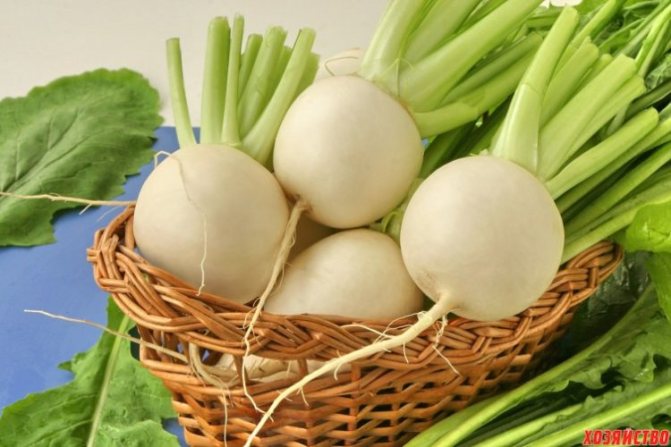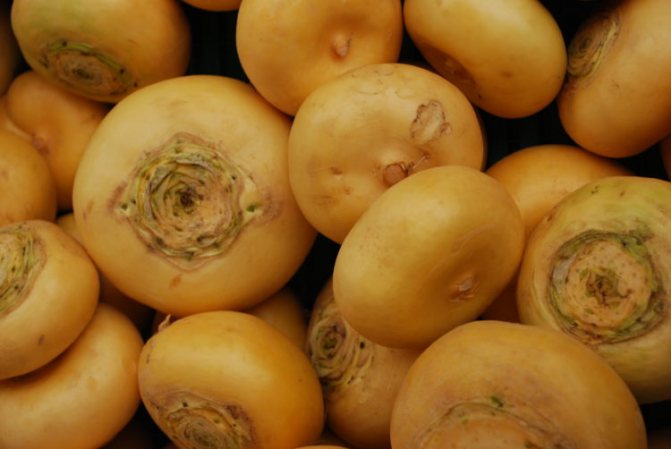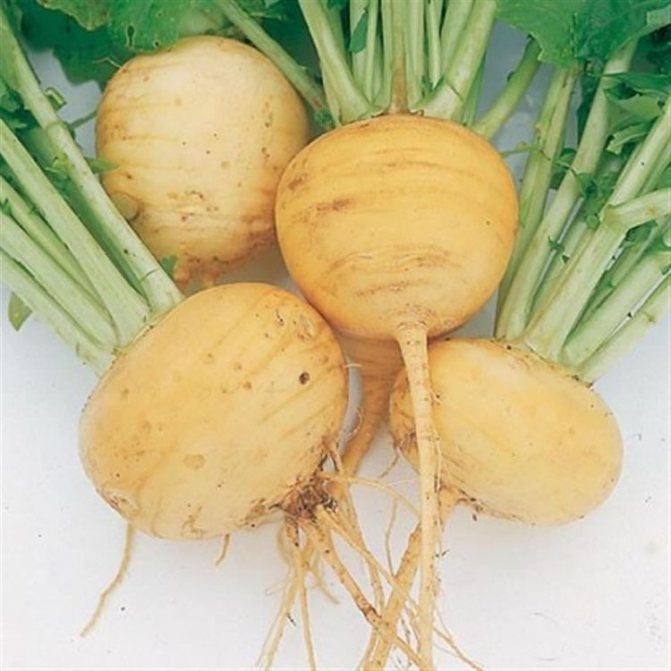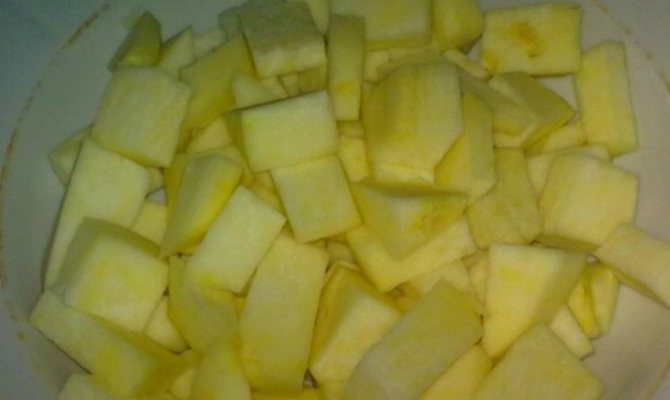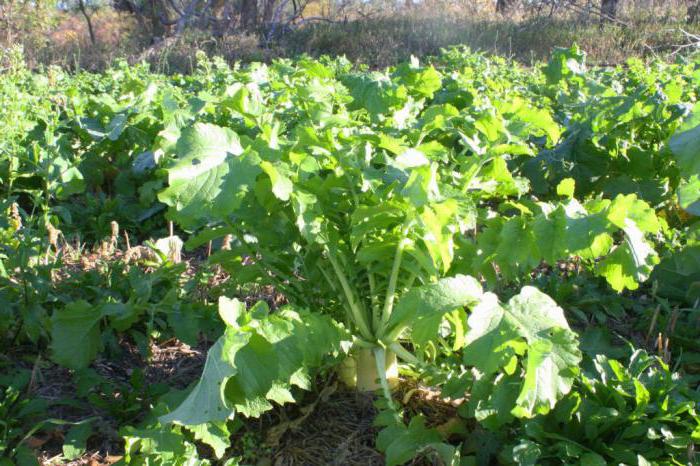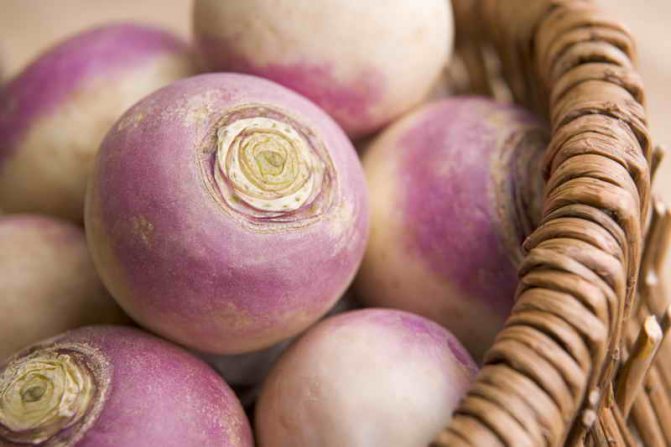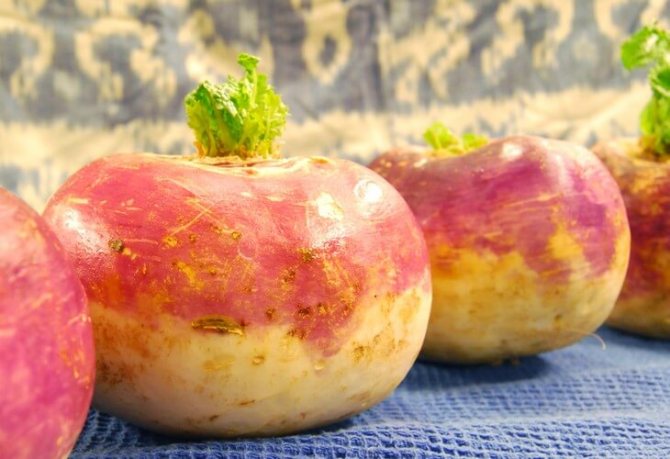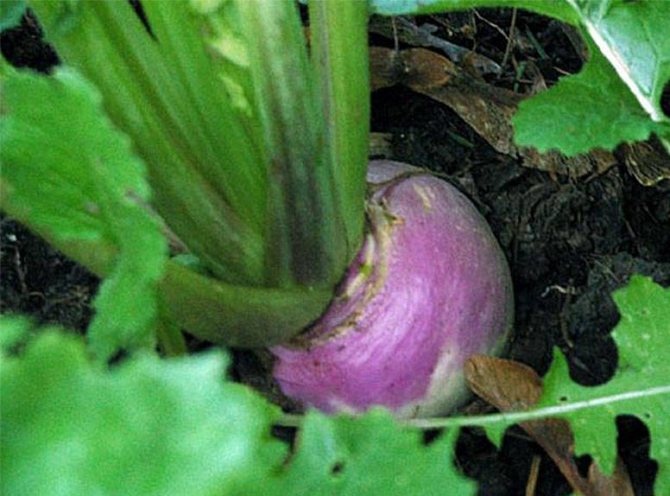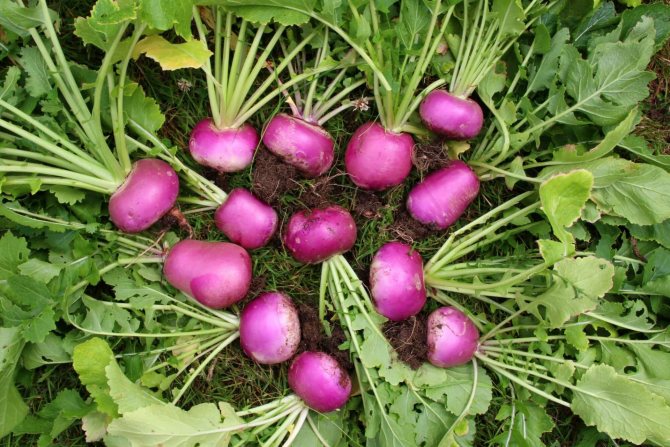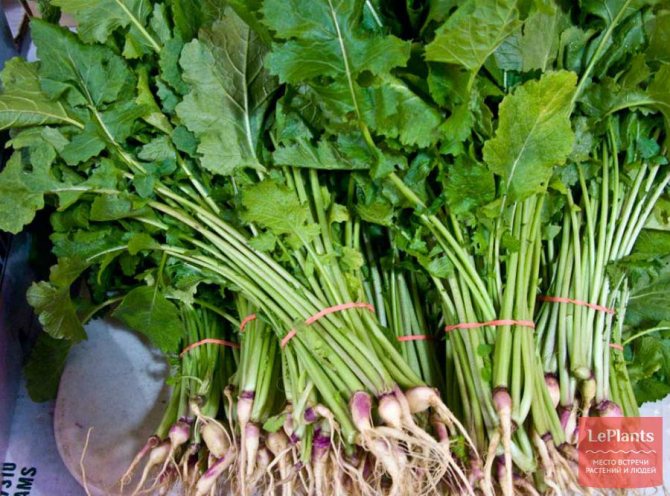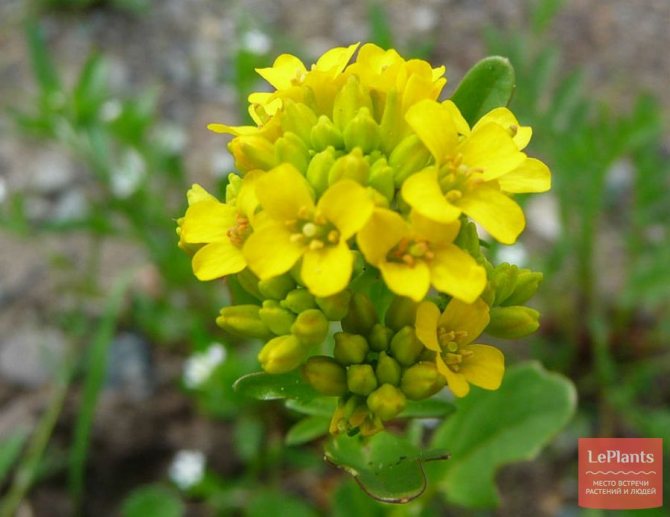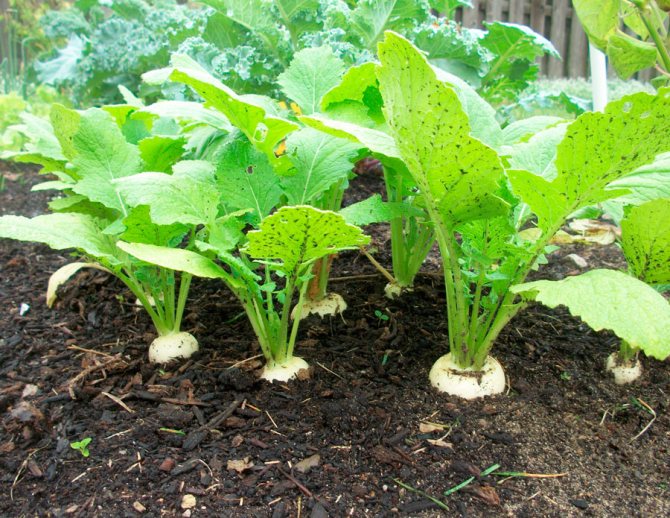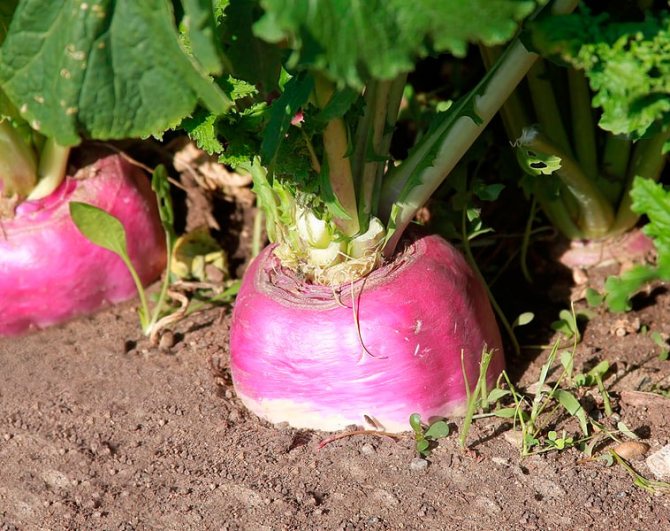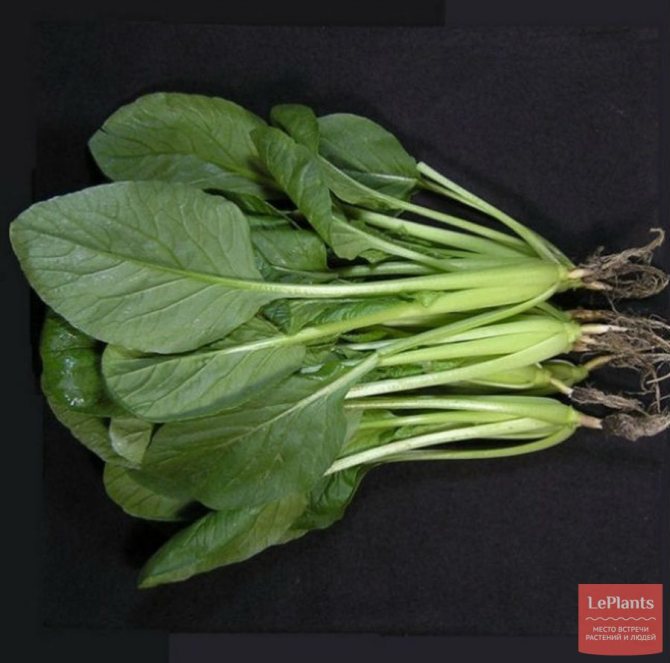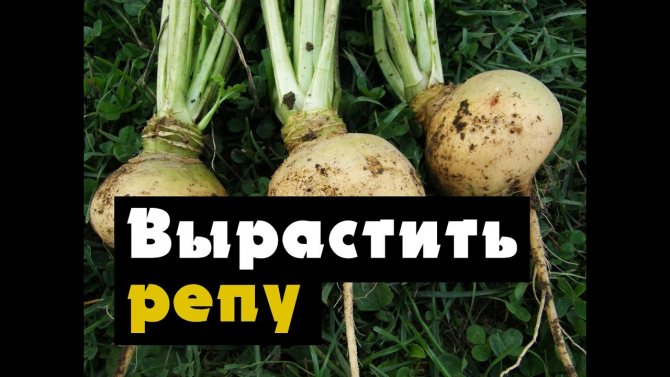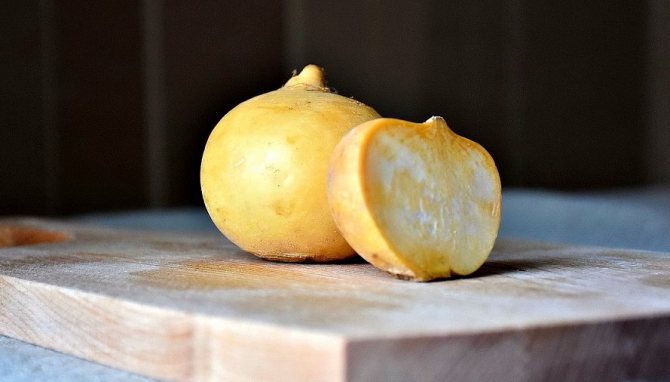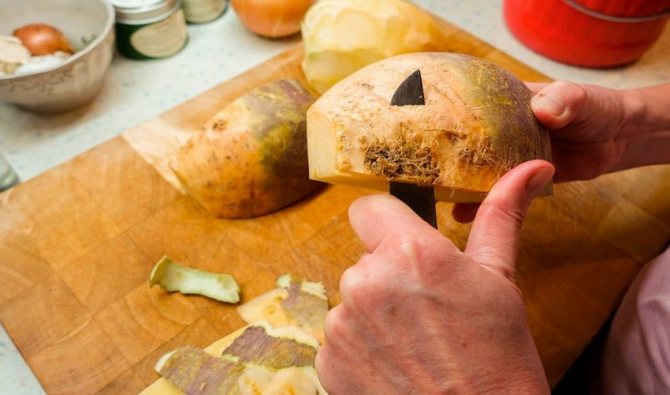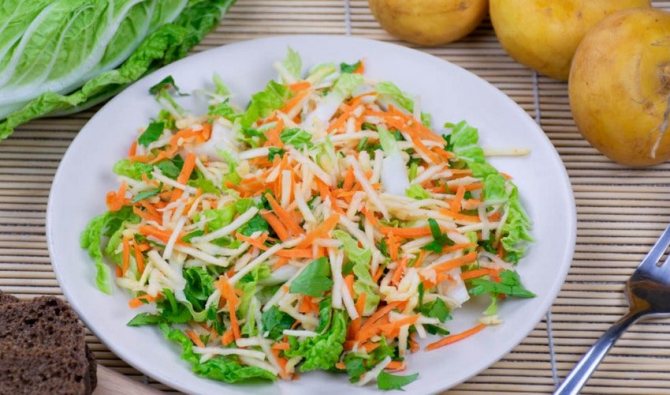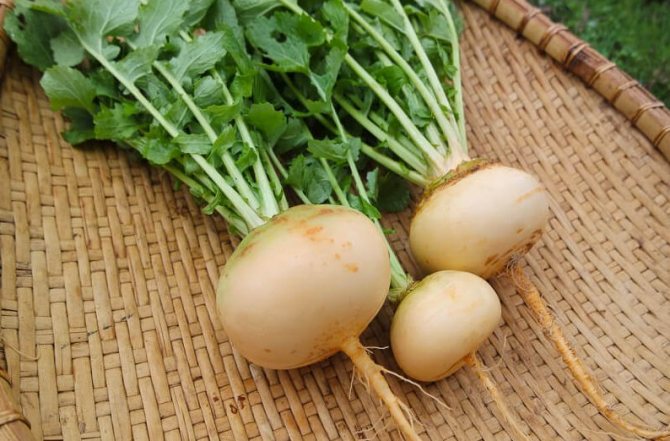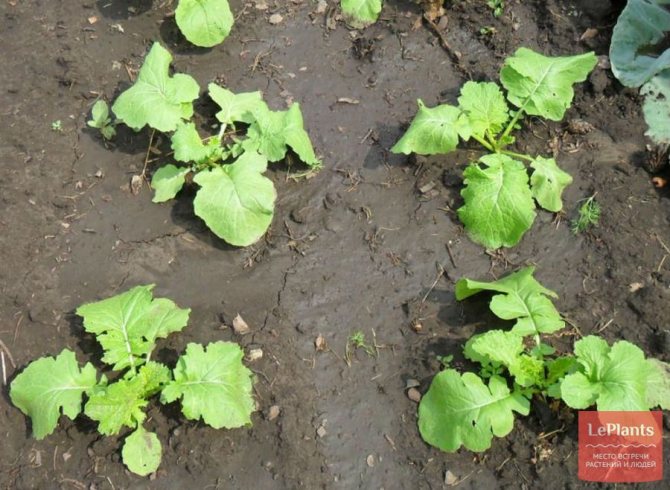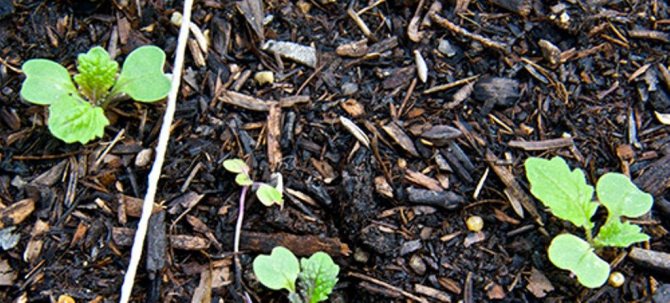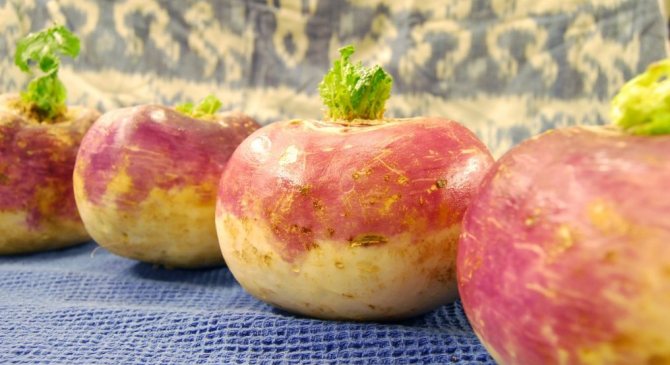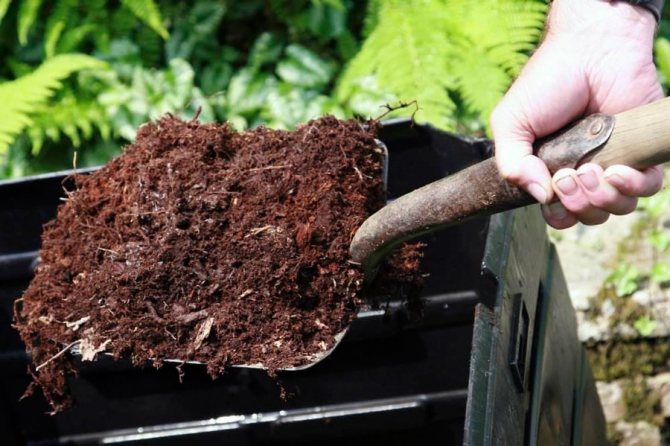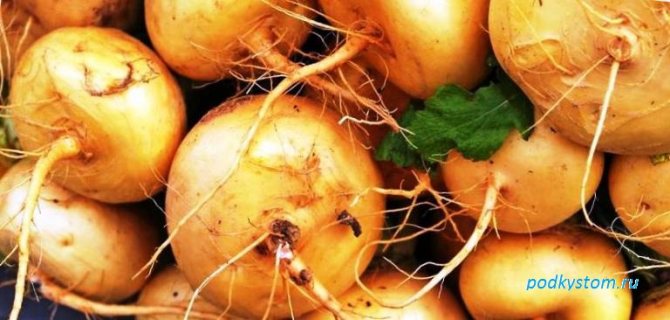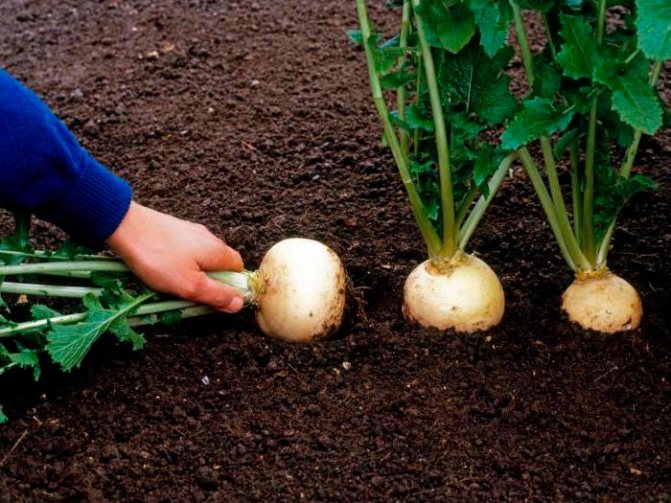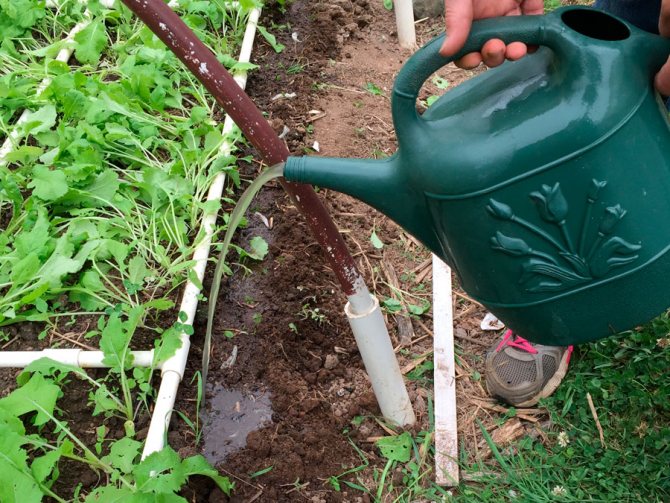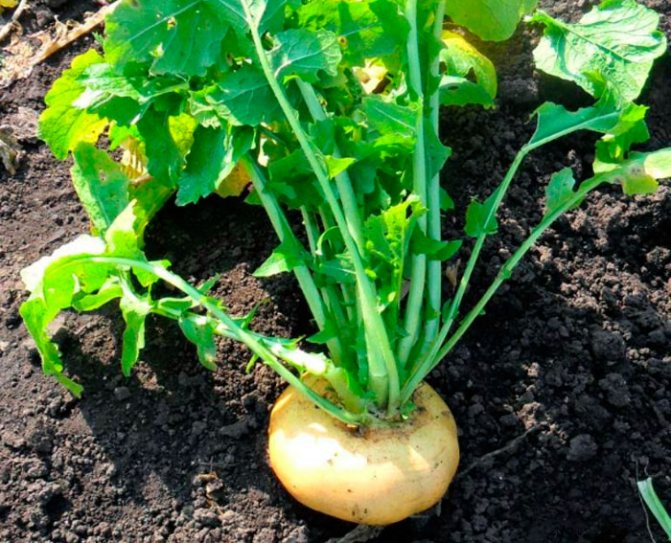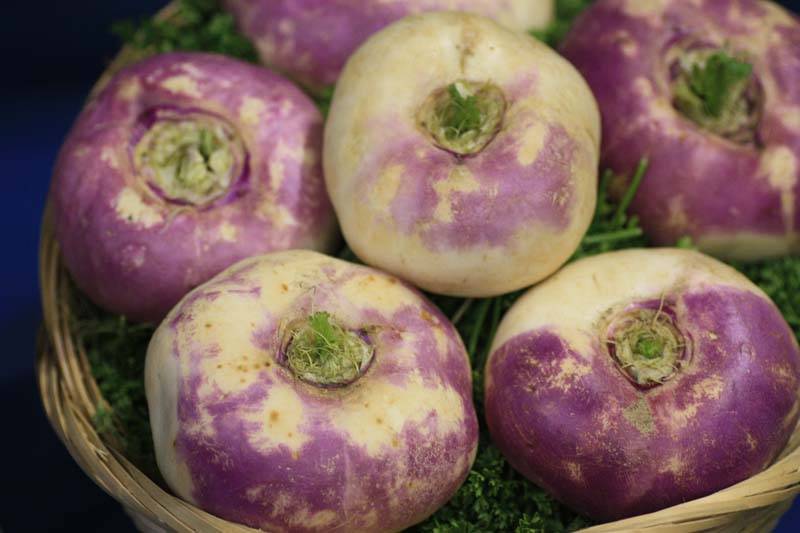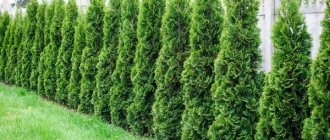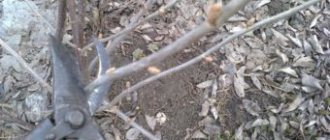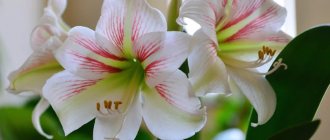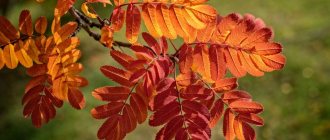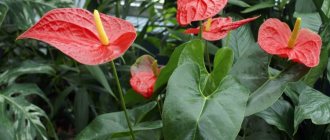What does the photo look like?
The turnip root crop is a modified root, it is smooth, fleshy, with a diameter of 4-6 cm; at the end there is a pod with a long nose. The shape of the turnip is different: round, slightly flattened or elongated. Depending on the variety, turnip skins can be: yellow, green, pink, burgundy, purple. The pulp of the fruit is yellow or white - juicy, with a rich taste.
If the top of the root crop protrudes from the soil during growth, it can change in color and turn brown, purple or even black. The weight of a mature root can reach 10 kilograms... The stem is tall with feathery green leaves attached to the root.
See clearly what it is and how a vegetable grows in the following photos:
Where is the culture grown?
The most suitable for this culture are sandy loam or loamy soils cultivated by peat. However, turnip also tolerates well the soil with high acidity. And varieties with flat roots can be planted in a shallow arable layer - up to eighteen centimeters.
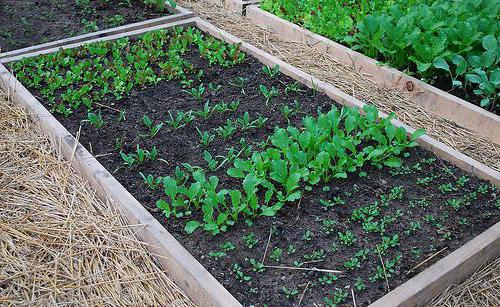
Those who are interested in how to grow turnips in the country should know that the best predecessors of this crop are tomato, cucumber, corn, zucchini, legumes and potatoes, for which organic fertilizers have already been applied. You should not plant a crop in highly acidic areas, especially after cabbage.
Botanical description
Turnip (lat. Brassica rapa L.) is a dicotyledonous herb, a species of the genus Cabbage (lat Brassica). This genus is well known for its nutritional, medicinal or feed properties.
In the first year, the plant produces an edible root crop and a rosette of basal leaves forms on the surface. Rosette leaves are long-petiolate, lyre-shaped. The stem reaches a height of 40-50 cm, its yellowish-green leaves are serrated, sessile, oval or slightly drooping.
In the second year of life, tall, branched flowering shoots appear. Turnip inflorescences are collected in shields, at the end of flowering they acquire the shape of a brush. Flowers are yellow or pale yellow. Pedicel 3-8 cm long at the end of flowering deviates at an acute angle. Fruits are erect pods with a long nose and small spherical seeds that have a burgundy-brown color.
There are 2 types of turnips: common (garden) and salad (kokabu)... The lettuce turnip is subdivided into leaf and root. The leafy turnip (komatsuna) does not form a root crop; the leaves of the plant are eaten.
Reference! The lettuce turnip was bred in Japan by crossing the Far Eastern and European turnips about 2 thousand years ago.
Growing turnip seeds
Old turnip varieties have survived to our time only because someone and somewhere grew them for seeds every year. The most difficult thing in this matter is to keep healthy and standard root crops selected for seeds until next spring. Since they do not need many, they can be stored separately in the ideal controlled refrigerator conditions at the correct 0 plus 1 degree temperature.
The tops of seed root crops are not completely cut off, but 1.5–2 cm are left. It is important not to cut off the apical bud.In the spring, they are planted together with grocery turnips, but leaving a sufficient food area, at least 50 by 50 cm under one bush.
The care of the seed plants is the same and at the same time as on the food plantations - watering, weeding, loosening, pest control. It is important that at the time of the flowering of the seed turnip, there are no flowering turnips of other varieties in the vicinity, as well as flowering crucifers - radish, radish, turnip, because cross-pollination is possible. Although different plants bloom, as a rule, at different times, the possibility of cross-pollination exists. If it is impossible to remove unwanted blooming neighbors, you can cover the testes temporarily with a non-woven covering material. This will save from wind-pollination, but insects can bring unwanted pollen. And we should not forget that the bush itself must be pollinated by wind or insects.
Seed maturity is determined by color
- Pods - they become dry and brighten.
- Seed - mature brown seeds.
Bushes with mature seeds are cut, tied in bunches, dried under a canopy. Then they are threshed. Threshing is sown through a sieve with cells the size of the seeds, or winnowed in a sufficiently strong wind.
Turnip seeds remain viable for up to 5 years.
This year I tasted turnips for the first time in my life ... Yummy, it turns out! The taste is extraordinary, a mixture of corn and cabbage / Yellow, tasty. Just boiled with butter - well, just delicious. But we don't sell it, as luck would have it! For 33 years I met for the first time on sale. And she was small, dry. I decided to grow and bought seeds, grade "Petrovskaya".
Yusya
I also plant a turnip Petrovskaya. I tried Russian Size, but it turned out not very juicy, I will not repeat it again. They planted this year on June 14, densely, and around the middle of July they planted it on another bed according to the 15 by 15 cm scheme, they did not have to thin out and the turnip grew very even and beautiful. We eat raw turnips, I'll try to bake this year.
Tatiana Senchukova
About flea beetles: I learned the recipe and was delighted. Dog flea shampoo - three tablespoons in a bucket of water and spray this compound on the ground where turnip shoots should emerge or have just emerged. Fleas do not tolerate this smell. Dogs are harmless, these substances will evaporate and will certainly not harm us. Just in case, after such spraying, I covered it with a non-fabric - so that fleas would not fly back. I sprayed it once a week until the leaves get stronger - the flea eats only young leaves, then they become stiffer, a fluff grows on them, which does not allow the flea to sit comfortably there. My turnips grew from half a kilogram. Turnip loves short daylight hours, and therefore in summer it can shoot. For summer consumption - we plant as early as possible ("in the mud") - because she is not afraid of frosts. This also additionally protects against fleas. The seedlings will get stronger before the flight of the midge begins (this is someone who is lucky with the weather). And for laying in the bins - we plant in the middle of summer, so that the daylight begins to shorten.
Tall Blond
Structure
The type of turnip fruit - a root crop - is not the most typical for the Cabbage genus, among which the taproot system prevails. The turnip root system penetrates deeply into the soil, the root is transformed into a root vegetable, which is a thickened adventitious root. In the structure of the root crop, the most important role is played by the storing main tissue.... For the unusual structure of the flower, representatives of the Cabbage family received a second name - Cruciferous.
The formula of the flower is as follows: Ч4 Л4 Т2 + 4 П1, where:
- Ч4 - four sepals arranged crosswise.
- L4 - four petals, cross to cross.
- T2 + 4 - two short and four long stamens.
- P1 - one pistil.
Growing problems
- 1If the root crop is formed slowly, then the turnip is cold. When choosing a variety, pay attention to its cold resistance. Grow turnips in a greenhouse.
- 2 A sign of sulfate deficiency is loss of color in the shoots, yellowness of the leaves. Feed the beds.
- 3 Bulges and growths on the root system are the keela, a fungal disease of cruciferous plants. For prevention, alkalinize acidic soil with lime.
- 4 Will enhance the resistance of turnips to boron bacteria. It should be added to the site before sowing 1.5–2 g per m2. Turnip grown on such a site will be more sugary, better stored.
- 5To form marketable root crops, after thinning, no more than 40-50 plants should remain per square meter.
Biological features
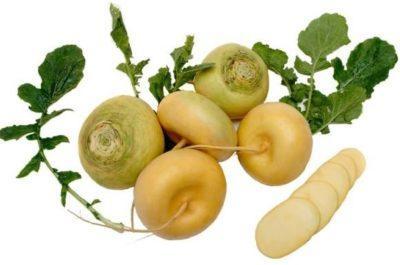

Turnip is a cold-resistant and moisture-loving culture. The seeds germinate at 2-3 ° C and withstand light frosts down to -3-5 ° C. The favorable temperature for growing is 15-18 ° C. With a combination of abundant watering and moderate temperatures, a high yield is guaranteed and flower stalks may appear in the first year of development. Turnip is a long day plant and requires adequate lighting.
The growing season is from 40 to 50 days, depending on the variety. To obtain a good harvest, planting in non-acidic soils is recommended; light loamy soils pre-enriched with compost or manure are best suited. It is recommended to feed the plant with ash.
It is undesirable to sow turnips after those crops that belong to the Cabbage family. Legumes, cucumbers or tomatoes are considered good predecessors.
Turnip planting - agricultural technology
Turnip is an early ripening crop, which allows it to be sown several times per season. Mostly it is grown in two, less often three times. For summer consumption, seeds are sown in spring - in the Kuban at the end of March-April, and in central Russia - at the end of April-beginning of May. The harvest is ready in 60-70 days.
For autumn use, July sowing is acceptable, the growing period is 50-60 days. To bookmark for winter storage, sowing is carried out in late July-early August, the crop is harvested after 70-75 days.
With spring sowing, the soil begins to be prepared in the fall. An autumn digging is carried out with the introduction of the necessary fertilizers. In the spring, deep loosening (up to 20 cm) is carried out with the introduction of the rest of the fertilizers. For summer sowing, the soil is dug to a depth of 20-22 cm, watered before sowing (15-20 liters of water per 1m2.
Turnips can be grown on a flat surface (in summer) or on ridges or ridges (in spring). The distance between the rows is 30 cm.
It is grown as a 2-3rd crop after the application of manure. If organic matter was not introduced, then 2-3 kg / m2 of humus is given under the fall. Phosphorus and potash fertilizers are applied in the fall (2/3 dose) and under pre-sowing treatment (1/3 dose). Nitrogen fertilizers are fed in the spring. Approximate doses of fertilizers: urea - 10-15 g / m2, superphosphate - 30-40 g / m2, potassium chloride - 15-20 g / m2. If necessary, liming of the soil is carried out.
Seed preparation for sowing includes calibration and soaking. For convenience, uniformity of sowing, seeds are mixed with sand or a mixture of sand with superphosphate. On the marked rows, grooves are made with a depth of 1.5-2 cm, which, if necessary, are moistened. Sowing with watering is especially important during summer and autumn growing periods.
The seeding rate is 1-0.15 g / m2. The seeding depth is 1-2 cm. You can also sow by the nest method, 2-3 seeds per nest, followed by thinning. Seedlings usually appear in 4-7 days, depending on the temperature.
Crop care includes the fight against the soil crust, for which they carry out shallow, 3-5 cm, loosening. For the entire growing period, 3-5 inter-row treatments are carried out.
Before the formation of three true leaves on the plants, they are thinned out. The distance between plants in a row is 6-8 cm (with summer crops - up to 10 cm).
About 48 plants are placed on 1 m2.
The soil should be constantly moist, the irrigation rate is 10-20 liters of oxen per 1 m2. It is recommended to alternate watering with loosening.
The main points of agricultural technology for growing turnips are:
- fighting cruciferous flea and cabbage fly;
- ensuring sufficient moisture and cleanliness of the soil;
- ensuring optimal plant density.
Does the plant differ from others or not?
From radish:
- the shape of the radish root crop is more elongated;
- the most common is black radish;
- the radish has a characteristic pungent taste with bitterness.
From swede:
- rutabaga usually has a harder, soft orange flesh;
- the fruits of the swede are larger;
- rutabagas are more nutritious than turnips, but inferior to them in taste.
Turnip for weight loss
When losing weight, turnip is an extremely necessary vegetable, since it not only speeds up metabolism and activates metabolic processes, but also helps to replenish the reserves of vitamins and minerals in the body. There are even turnip diets. They last no more than a week, so as not to harm health, and involve the introduction of root vegetables in the diet in the form of salads, as well as as a side dish to protein products.
On a turnip diet, gradual introduction of the product is very important. That is, if you have never tried the root crop before, and then abruptly went on a diet and replaced most of the products with it, then problems with the digestive tract may arise. It is recommended to adhere to the diet for no more than a week, then you can take a short break (14 days) and repeat.
Turnip is an excellent substitute for potatoes, which are not very good for the figure. This alternative fits perfectly into any diet.
Benefit and harm
The plant has many beneficial substances. Turnip components have a positive effect on:
- metabolic processes of the body;
- help to strengthen the immune system;
- elasticity and strength of blood vessels;
- nervous system.
Vegetable products have pronounced bactericidal and antiseptic properties.
Turnip is contraindicated for:
- chronic diseases of the gastrointestinal tract;
- disorders of the thyroid gland;
- pathology of the kidneys and liver;
- severe forms of diabetes;
- nervous disorders.
Turnip breeding history
The turnip belongs to the Cruciferous (genus Cabbage), it is considered an annual crop (maximum two years). In the first year, it forms a root crop, and in the second year, seeds can be obtained from it. The birthplace of turnip is considered to be Western Asia. It was cultivated about four thousand years ago. In the ancient states of Greece and Egypt, turnip was the food of the poor and slaves, but in the Roman Empire it was served on the table even in rich and noble families.
Turnip came to our country from Greece in about the XIV century and for a long time was the main product, the mention of which is found in ancient Russian treatises. It was only at the end of the 18th century that the potatoes imported from overseas began to give way. They sowed it everywhere, even on the Solovetsky Islands. The land under the crops of turnip was called turnip. From it they prepared the now forgotten dishes: turnip from grated turnip with cereals; turnip, or turnip, - turnip stew with malt or oatmeal, baked turnip pies. Since turnip is a rather dull root crop, you can feast on it throughout the year.
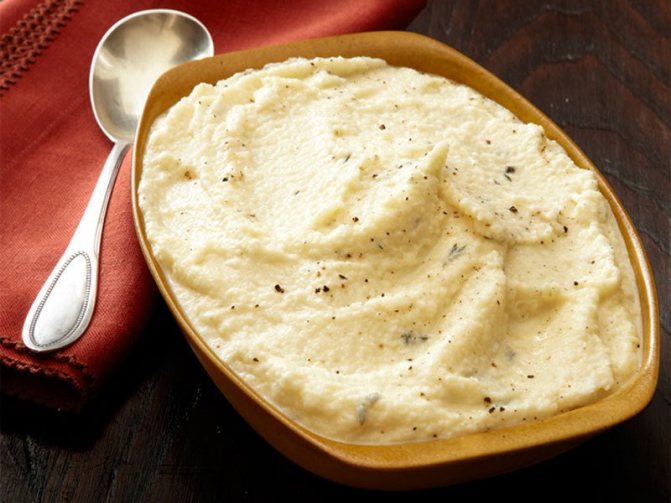

Turnips can be cooked in completely different ways.
Root vegetables can be eaten fresh and subjected to various types of culinary processing (stew, boil, fry, bake). They are delicious stuffed. The root vegetable can be added to the first and second courses.
In salad varieties of table turnip, even leaves are eaten. This also applies to the leafy variety, in which root crops are not formed. Pollination in turnips occurs in a cross way. Therefore, it is able to interbreed with related plants, especially with the rape, rutabaga. The leaves are located on the flowering stem. Turnip flowers are yellow, represented by inflorescences. The fruits are pods.
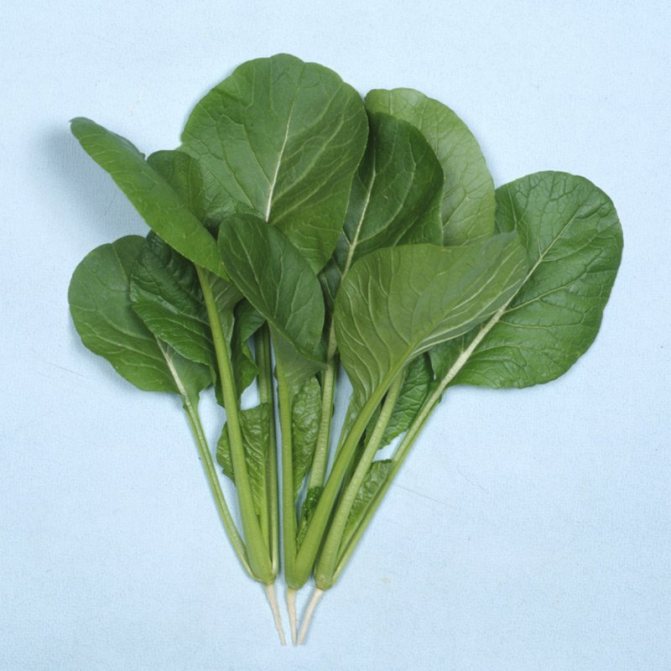

Turnips are grown for vitamin-rich salad tops, and not just for root crops.
Turnip is not only a valuable food, but also a medicinal product. The combination of specific aroma and peculiar taste is provided by the presence of sugars with mustard oil contained in root crops. The composition, in addition to basic proteins, fats and carbohydrates, is enriched with vitamins (including carotene, group B), potassium salts, calcium and phosphoric acid salts. The turnip contains succinic acid. Thanks to its bouquet of useful substances, it has a diuretic, relieves inflammation, healing, anesthetic, antiseptic effect. With its regular use, appetite improves, the digestive tract normalizes, and the digestibility of food improves.
Use for treatment
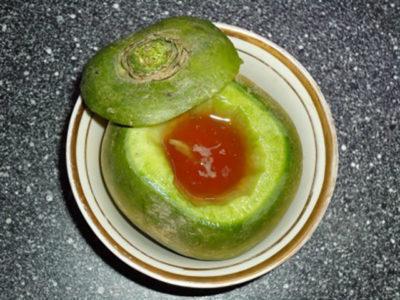

Turnip juice with honey... The turnip is passed through a meat grinder or juicer and the juice is decanted. The juice is mixed with honey in a one-to-one ratio. Take one spoonful after meals 3 times a day. It is indicated for colds and as a prophylaxis for acute respiratory infections. We wrote about the benefits and contraindications of turnips with honey in a separate article.- Decoction... Grate 1 turnip and pour boiling water over it, cook on fire for 15 minutes, then strain through cheesecloth. The broth is taken 3 times a day, 50 ml. It helps to cope with sleep disorders and infections.
- Compress... Grate the boiled turnips into a gruel and spread on cheesecloth. You can apply a compress to gout and sore joints for an hour.
Harvesting and storage
Turnips are usually harvested in early October. The crop should not be left until frost. Also, do not overexpose root crops in the garden: they will lose their taste, become rough, tough.
In order not to be mistaken with the timing of the harvest, check the inscription on the seed bag. There is written the ripening period in days.
Take the turnip out of the ground by hand. Sometimes you will have to use a shovel or pitchfork to dig. Damaged root crops should not be stored for long-term storage.
From a turnip pulled out of the ground, the tops must be removed immediately. You can leave only a couple of centimeters so as not to damage the roots during pruning.
If there is no rain, then the crop is dried right in the garden, up to 7 days.
Then the roots are cleaned of the remnants of the earth and put in boxes, sprinkled with sand. It is advisable that they do not touch each other.
In the cellar, where the temperature is about 2-3 degrees above zero, the turnip will be stored until the next harvest, while retaining the taste and vitamins.
Popular varieties according to characteristics
- Sweet:
- White ball and Snow White are milky white.
- The golden ball is an orange-yellow round root vegetable.
- Harvest:
- Petrovskaya - flattened yellow fruits.
- The Snow Maiden is snow-white fruits with a short shelf life.
- Tokyo is a salad subspecies.
- Large-fruited:
- White Night and Snowball - white vegetables weighing up to 550 grams.
- Russian size - a giant vegetable (up to 2 kg.), Yellow.
- Early ripening (40-60 days after sowing):
- Geisha is a white salad fruit.
- May yellow green-headed.
- Granddaughter - small yellow fruits suitable for winter storage.
- Mid-season (60-80 days after sowing):
- Dunyasha is a dietary variety with an orange peel.
- Gribovskaya - large fruits with a purple top and white bottom.
- Late (90 days after sowing):
- The comet is a white conical fruit.
- Pull-Pull - Round vegetables with sweet yellow flesh.
Turnip is distinguished by a variety of varieties for every taste, therefore, when choosing, it makes sense to be guided by such criteria as:
- ripening terms;
- zoning, i.e. for which region the variety is intended
- personal tastes.
Reference! The most popular variety among Russian gardeners is Petrovskaya, which gives a large harvest and is stored for a long time.
Turnip variety selection
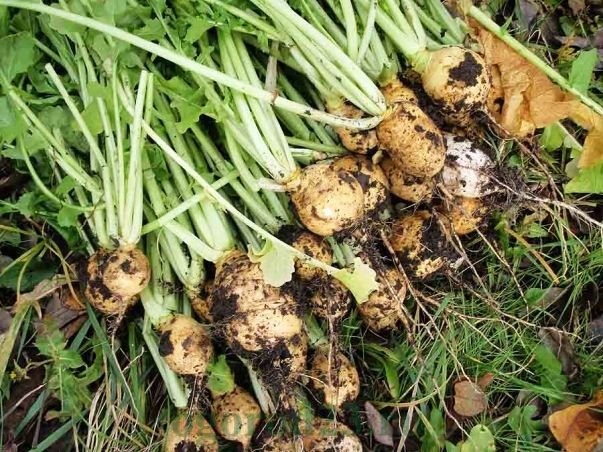

Turnip golden ball
We usually grow both old Russian varieties (Petrovskaya) and Japanese (Geisha).In addition to these varieties recommended by the State Register, the varieties Mayskaya yellow green-headed, Milanskaya white violet-headed, Golden ball, Snegurochka, and others are cultivated.
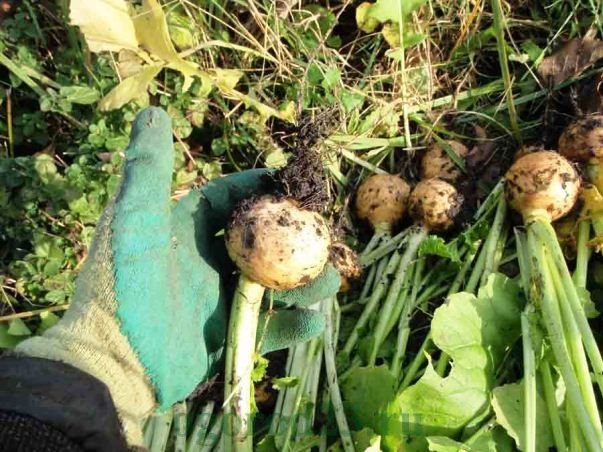

Turnip Petrovskaya
Features of planting and care
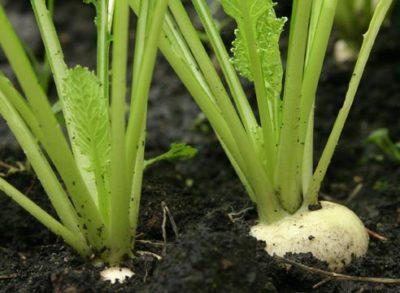

At home - can be grown for seedlings and further planting in open ground or until fully ripe on a balcony or loggia. Seeds are sown in February-March in sowing boxes and covered with foil until shoots appear (we wrote about when it is better to plant turnips here). Soil from a mixture of earth and sand (2: 1). Then the seedlings are either planted outside or thinned out. After the second thinning, the distance between the shoots should be 5-6 cm. Root crops with a diameter of 5-6 cm are removed.- In the greenhouse - it is possible to grow turnips in the autumn. Seeds or seedlings are placed in grooves at a depth of 6-7 cm, at a distance of 15-20 cm. The main care is abundant watering and a lot of light, as well as weeding and loosening of the soil between shoots. The last cleaning is carried out before frost.
- On the street - the seeds are predominantly sown in spring, but it is possible to sow seeds for the first frost, then young shoots will appear in the spring. During the summer, you can get 2 harvests of vegetables. Sowing and caring for a plant is similar to that of a greenhouse.
Turnip does not need feeding; with the right choice of soil, the plant has enough nutrition. Turnip does not like density, so it is imperative to thin out the beds and carry out systematic weeding.
Read about planting turnips here.
Turnip predecessors and neighbors
For the successful cultivation of turnips, as for many other vegetable crops, it is very important to observe crop rotation. This crop should not be planted after similar plants - all types of cabbage, radish, radish, mustard and other cruciferous plants. Cucumber, potatoes, carrots, beets and onions are also not the best predecessors for turnips. These are the same plants and unwanted neighbors for turnips. Turnips planted after peas, beans, tomatoes, celery or next to these plants feel good.
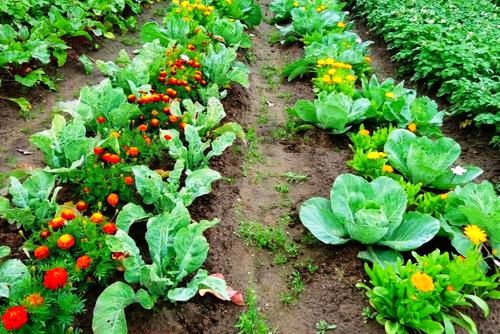

Marigolds and calendula are the best neighbors for all cabbages, including turnips
My childhood memories are connected with the turnip. Every summer I was sent to my grandmother in the village and those were really happy times. Freedom, air, river, forest and a lot of free time. And the turnip - for some reason she was especially remembered. Grandmother was a noble gardener, and all her vegetables grew and made both adults and children happy. Turnip turned out to be just a fabulous beauty - large, smooth, bright yellow, like the sun. My grandmother baked it in the oven with mushrooms or meat, whenever, and not in a clay pot. First, she boiled the root vegetable in water, then cut off the top in the form of a lid and took out the pulp with a spoon - a turnip pot was obtained. I filled it with stewed mushrooms or meat mixed with turnip pulp and put it in the oven. The dish turned out to be fragrant and very tasty. Now, for colds, we are preparing black radish with honey - a good cough remedy. Grandmother treated us with turnips, and who then heard about black radish. She gouged a hole in the raw turnip and filled it with honey. Within a few hours, the honey in the turnip turned into juice. We drank this medicine with pleasure, and it helped not only for coughs, but also for colds in general.
Undeservedly forgotten and supplanted at one time by potatoes, turnips are ready to return to our gardens. It is not difficult to grow it and it grows, due to its unpretentiousness, even in the most severe climatic conditions. Turnip dishes prepared according to old recipes will delight gourmets and fans of healthy eating with a new taste.
Use in cooking and cosmetology
According to reviews, you can eat turnips raw in the form of savory salads. The taste of a raw root vegetable goes well with all known dressings:
- any vegetable oil;
- all kinds of vinegar;
- lemon juice;
- cream;
- sour cream;
- mayonnaise;
- soy sauce.
Delicious side dishes for meat and fish are obtained from the root vegetable. For this purpose, it can be stewed, boiled, chopped to a puree state. It is not difficult to cook turnips correctly, it is enough to use the principles familiar to potatoes.
The rich composition of the pulp allows you to use the root crop in cosmetology. A large amount of antioxidants and vitamins improves skin color, strengthens hair follicles. Useful substances regulate fat content, heal and prevent the appearance of rashes.
Mask for oily skin
Features. The mask is used on the face and neck to eliminate oily shine, close pores, rejuvenate and slightly whiten the skin.
Preparation and application
- Two tablespoons of finely grated turnip pulp are mixed with a quarter cup of yogurt or low-fat kefir.
- Five drops of freshly squeezed lemon juice are added to the mixture.
- Mix the composition thoroughly.
- Apply on face and neck for 15 minutes, then wash off with warm water or infusion of a series.
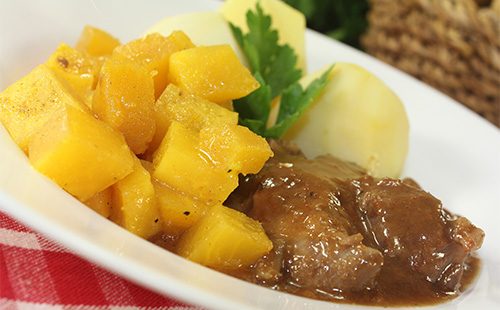

Moisturizing with dry integument
Features. Suitable for moisturizing sensitive skin. An important feature is that there should be no allergy to honey.
Preparation and application
- Mix a couple of tablespoons of chopped turnip pulp, a couple of tablespoons of any vegetable oil and a spoonful of liquid honey.
- The composition is applied to the face and neck, washed off with warm water after a quarter of an hour.
Strengthening hair
Feature. Making masks with turnips for hair at home is as easy as shelling pears. It not only activates hair growth, eliminates brittleness and nourishes the bulbs with useful substances, but also overcomes dandruff, and also regulates the oiliness of the scalp.
Preparation and application
- Peeled turnips are rubbed on a fine grater.
- The resulting mass is applied to the hair along the entire length, actively rubbed into the scalp with your fingertips.
- Wrap hair with cling film, towel on top, leave the product for half an hour.
- The hair is washed well with water, after which it is washed with shampoo.
The harm to health of turnip can manifest itself with its excessive use. If you introduce the root vegetable into the diet gradually, but consume it regularly, the health benefits will appear in a couple of weeks. The use of turnips rarely provokes allergies, but it is better to introduce it into the child's diet starting with small amounts.
Diseases and pests
Turnip, like its cruciferous relatives, has the same diseases, so they are not grown in close proximity.
Turnip sick:
- gray rot;
- black leg;
- keel;
- vascular and mucous bacteriosis;
- phomosis.
Of the insect pests, turnips are most often disturbed by cabbage flies, cruciferous bugs and fleas, cabbage moth, cabbage scoop, cabbage aphid, cabbage stem weevil, cabbage and turnip whites.
To protect it from these misfortunes, you need to monitor compliance with crop rotation and comply with all agrotechnical requirements: prepare and pickle seeds before planting, do not thicken the crops, regularly fight weeds, destroy plant residues and be sure to dig up the ground.
If, nevertheless, fungal diseases have not bypassed your crops, then ruthlessly remove the diseased plants from the garden, and treat the remaining plants from the beginning with herbal remedies, and if it does not help, then with fungicides: topsin, foundation.
To combat insect pests, they use proven means: a decoction of potato or tomato tops. The tops should be boiled in water for at least half an hour.
The resulting broth is filtered and diluted with water in a ratio of 1: 3. Before direct processing of turnips, it is necessary to dissolve 40 g of soap previously grated in 10 liters of diluted broth. This will help the plant to get rid of whites, scoops, flies, moths. From a large number of insects, crops are treated with Metaphos, Karbofos, Aktellik.
Turnip sowing dates
For summer consumption, turnips are sown in early spring, as soon as it will be possible to "climb" into the garden after the snow melts, but with the expectation that after the turnip sprouts there will be no night frosts.
Root crops intended for long-term winter storage, as well as mother plants, are obtained from the July sowing, which is carried out on the 5-10th. In the northern regions, it is necessary to choose such a time frame so that 85–90 days remain until the end of the growing season. Earlier dates will lead to overgrowth of root crops. In this case, they will be less tasty and will not be stored for a long time.
|
"Ural gardener", 2019, No. 10
How to feed turnips after germination so that they are sweet and large?
Turnip is very responsive to good care and quickly gains in growth, tying a large root crop. Top dressing, if the soil was well fertilized in advance, can be skipped. Before feeding, the soil must be shed well with water so that the fertilizers quickly reach the root system. Or feeding is carried out after rain.
If there is a need for feeding, it is carried out a week after germination. During this period, the plant especially needs fertilizers for the development of green mass and root crops. For this purpose, use herbal infusion, infusion of chicken droppings. Of mineral fertilizers, nitroammophoska is well suited. It contains all the elements necessary for a plant - nitrogen, potassium, phosphorus. The fertilizer is scattered over the surface of the row spacing - 1-2 handfuls of fertilizer per 1 sq. m, then the ground between the rows is watered and then loosened. Or prepare a solution according to the instructions on the package.
Some gardeners recommend watering the aisles with salt water, believing that this will add sweetness to the root crop. Although without such feeding, the turnip is already sweet.
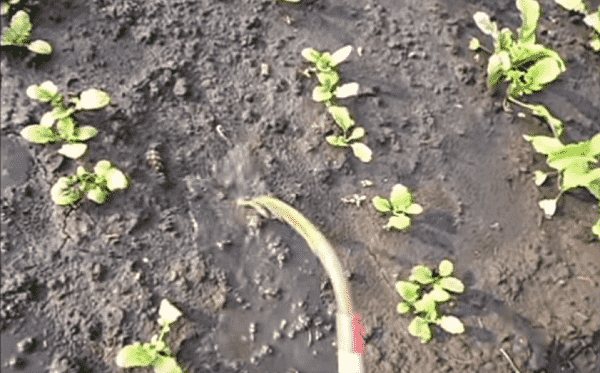

Large-fruited
These species are distinguished by strong, rather large fruits of different colors, with good storage during the harvest saving period.
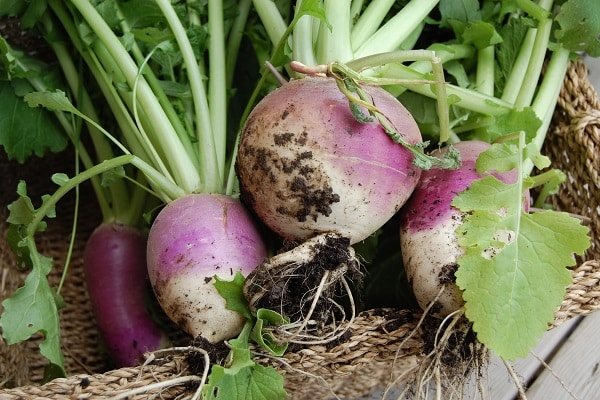

White Night
A type of turnip native to the Czech Republic. Mid-season in terms of growing season. The fruits are white, buried in the ground by about two-thirds, and weigh about 0.5 kilograms. The pulp is juicy inside, without characteristic hard inclusions, somewhat similar to a garden radish.
Golden ball
Another mid-early appearance, the color of the fruit is bright yellow, with a shiny skin. The weight of one turnip is up to 400 grams, the taste is mildly sweet, with a juicy core.
Russian size
The variety seems to have descended from the pages of a collection of Russian fairy tales: massive, heavy fruits weigh up to 2 kilograms. At the same time, they retain all the useful properties of ordinary turnips - sweetness, moderate hardness, juiciness, and a characteristic “turnip” aftertaste.
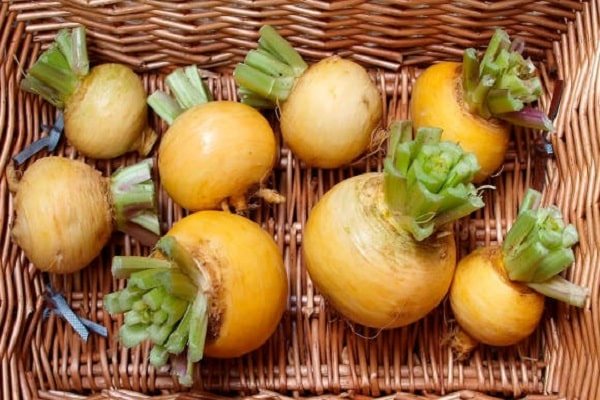

Snowball
An early variety with rounded, white roots. The weight of one turnip ranges from 90 to 200 grams, the taste characteristics are at the level of the best specimens. Turnips are usually shallow in the ground, easy to pull out, and store well after harvest.
Site preparation for growing
Turnips, due to their early maturity, can be sown twice or three times over the summer, so that this wonderful vegetable is always on the table.
If winter storage of turnips is planned, then sow a late-ripening variety.
There is nothing difficult in growing turnips in the country, however, like any crop in the garden, it has its own preferences, and first of all, the right place for planting turnips in open ground.
It should not be in a draft and in the shade, this vegetable needs good lighting, but hot sunlight is undesirable.
It is good if it is a flat area in a small lowland in order to retain the moisture necessary for the plant to the maximum.
Determination of soil composition
Turnip grows very well on light soil - peat, sandy loam, loam. How to figure out what kind of soil is in a place sown with turnips?
It is very simple to do this: take a little earth in your hand, slightly moisten it and rub it on your palm.
Determine the composition of the soil according to the degree of pollution:
- if the palm is practically not dirty, then the soil is sandy;
- if the skin is slightly dirty, it is sandy loam;
- if the pollution is accompanied by a slight smearing effect, then it is a light or medium loam;
- a solid layer of dirt has formed on the palm - this is heavy loam or clay.
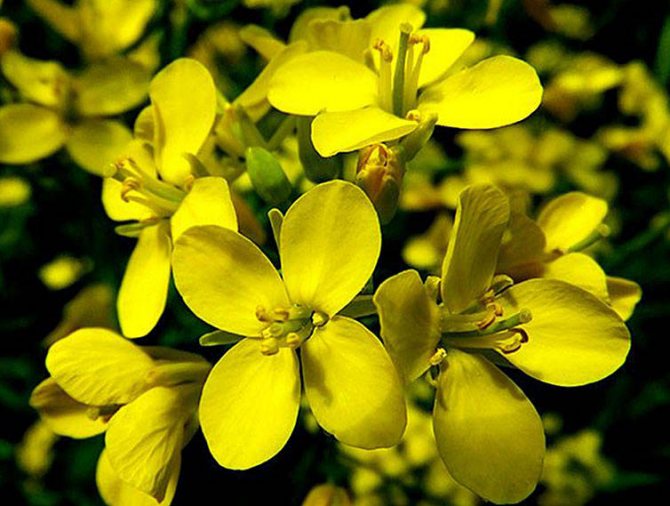

Heavy soil is not suitable for sowing root crops.
It needs to be loosened with brick chips, river sand, charcoal or straw cutting.
Clay soil becomes looser after growing green manure - phacelia, oats, vetch, lupine.
Sow them in early autumn, cut them off before the very cold, leaving them on the surface of the ground, and with the onset of spring, close them up in the garden.
Optimizing acidity
The soil for growing turnips should be fertilized and have neutral acidity.
The most optimal pH level is considered to be close to 7.0.
The easiest way to determine the acidity of the soil is with litmus strips, which can be purchased at any horticultural department.
Instructions for use are attached to them.
If the soil is acidic, lime it. This can be done with:
- lime flour;
- dolomite flour;
- slaked lime;
- ground chalk;
- peat ash;
- wood ash.
Turnip grown on acidic soil without liming does not tolerate long-term storage.
Then plant and what can be planted after turnips
Compliance with crop rotation is a prerequisite for growing healthy vegetables in the garden, including turnips.
A competent neighborhood of crops for compatibility will help to avoid an outbreak of the disease and prevent pests from destroying the crop.
This root crop feels very good after beans, tomatoes, cucumbers, potatoes.
Not the best option to sow turnips after watercress, rutabagas, mustard, daikon, horseradish, radish, radish, turnip, any kind of cabbage, since they are prone to the same diseases and pests.
In this case, find another place for the turnips.
Turnip, where will you live?
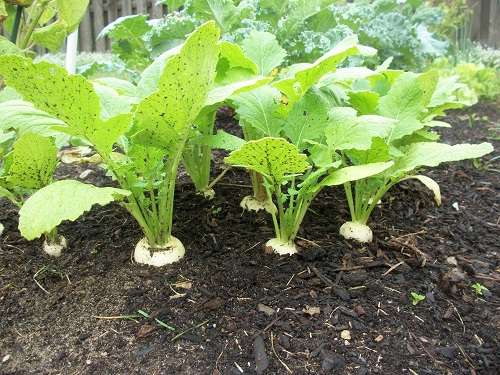

The turnip feels great after any vegetable crops (cucumbers, tomatoes, corn, potatoes, pumpkin, legumes or squash).
But this beauty will not become a follower of cruciferous plants (radish, cabbage, daikon, radish).
A turnip planted after such crops runs the risk of getting sick due to oversaturation of common pests and acidity of the soil.
In such areas, turnips should be planted only after 4-5 years.
In order for the planting of turnips and its further development to be successful, take into account the wishes of the Russian garden beauty.
Where not to plant the root vegetable:
- In the soil, too oversaturated with organic matter and rotted fertilizers. Such soil negatively affects the quality of future fruits - tasty root crops can become frail and hollow.
- In poor soils, where there are few nutrients. With a deficiency of a mineral such as boron, turnip fruits will develop with voids and acquire bitterness.
What does a turnip need? Fertile and light soil! Loose, and by no means clay!
To compensate for the lack of nutrients, when digging and preparing the beds for sowing turnips (digging is carried out to a depth in the bayonet of a shovel), the following fertilizers are applied (for each square meter):
- Nitrogen, potassium chloride and urea (20 g each).
- Potassium and superphosphate (40 g each).
If the soil on your site is loamy, during the autumn preparation of the beds for planting turnips in the ground, add a mixture of humus and sand (5-6 kg per square meter).
Humus can replace manure. We add it together with slaked lime (500 g of lime and 5 kg of manure per square meter).
In the presence of sandy soil, we add one humus (8-9 kg per square meter).
If you did not manage to prepare the site for planting turnips in the fall, then in no case in the spring do not bring fresh manure before planting.
Do not forget to season the ground in the spring (when loosening) wood ash (300-350 g per square meter).
Ash will protect young turnip seedlings from the voracious and dangerous cruciferous flea.
Chemical composition
Turnip has a very rich composition, and in many respects it surpasses the usual roots (potatoes, beets, carrots).
This vegetable contains:
- the amount of vitamin C is twice as much as in oranges and lemons;
- vitamins of group B, PP, A;
- minerals (calcium, magnesium, phosphorus, sulfur, iron, manganese);
- fiber, pectin and starch;
- succinic acid;
- essential oils (mainly mustard), which impart a characteristic sweetish-spicy taste with a slight bitterness;
- bactericidal substance synergin;
- enzymes myrosin, invertase, peroxidase;
- from 3 to 10% sugars;
- up to 3% protein (in leaves).
Did you know? Every November, the streets of the Swiss town of Richterswil are decorated with turnip lanterns, marking the start of a festival dedicated to this vegetable. The turnip parade and fair have been held there for almost a century.
Dangerous diseases of the turnip
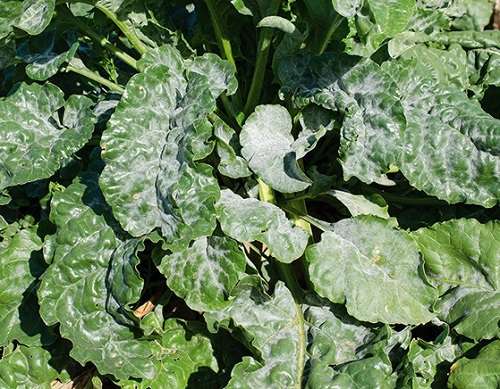

The turnip, like other vegetable crops, is threatened by the following diseases:
White rot... Culture tissues affected by fungi become watery, thinner and covered with a white bloom (mycelium).
Gray rot... This fungal disease is dangerous for the harvested crop. Fungi attack root crops, destroying the turnip crop.
Radish Mosaic... The viral disease affects the development of the turnip.
The plant stops growing, the leaves become fragile and thin, ring-shaped patterns and spots form on them. Young leaves begin to curl.
Powdery mildew... The disease affects the entire plant. The disease begins with a white powdery coating that darkens over time.
The affected areas dry up. The plants themselves begin to lag behind in development and die.
Pernosporosis... The disease affects the leaves of the vegetable.
The ailment begins with the appearance of small white specks that spread throughout the sheet, turn brown and become oily.
Blackleg... The disease affects the lower part of the leaves and the root crop.
The affected areas darken and become thinner. The fruit softens and becomes covered with a whitish mycelium-mycelium.
On the cut of the affected turnip, dark flesh is visible.
What to do when you see symptoms of ailments?
To keep your pet safe from disease, carefully follow these guidelines:
- Observe the rules of crop rotation, agricultural technology.
- Be sure to prepare plant seeds before sowing.
- All diseased crops should be immediately removed from the beds and destroyed.
Soil preparation (complete destruction of all plant residues and the fight against increased soil acidity) is also of great importance when planting turnips.
In acidified areas, the turnip is most susceptible to disease.
Varieties and types
There are a lot of varieties of turnips. There are those in which not only "roots" are edible, but also "tops". When choosing a variety, it is recommended to be guided by the ripening time, zoning of the variety, and taste. When choosing, amateurs are guided by the color of the root crop (except for yellow and white turnips, pink, green, and purple varieties are also bred).
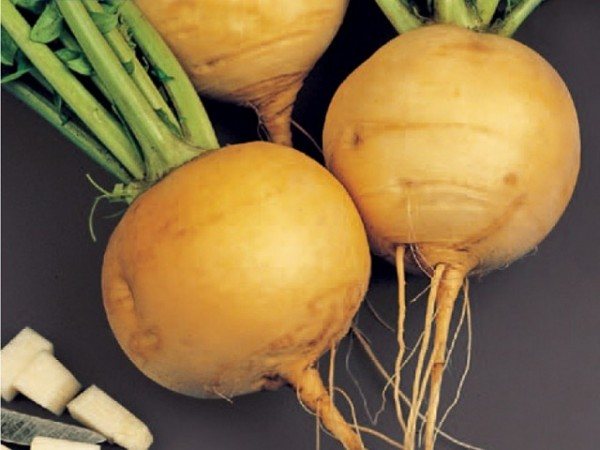

The most proven varieties:
Early ripe
Granddaughter... Yellow, rounded roots with dense juicy pulp.
Glasha... A flat white root vegetable suitable for culinary use. Both are versatile and can be stored well in winter.
Mid-season
Gribovskaya... Slightly flattened, the top is purple, the bottom is yellow.
Petrovskaya 1... Large golden roots with high yields.
Late ripening
Moon... Representatives of this variety are best eaten fresh.
Orbit... Large specimens. They are well kept.
Varieties can be classified by color:
- Milan... An early ripening variety with an unusual white-purple color and sweet snow-white pulp. Unsuitable for long-term storage.
- Snow Maiden... A very beautiful snow-white variety with white flesh.
- Burnt sugar... Black color, elongated shape. White juicy pulp.
- Turnips... The root crop came from the West.The shape of the tubers is most often oblong, there are also flattened specimens. Turnip is notable for its beautiful skin color. He has it purple with a smooth transition to white or beige. There are even red specimens. The taste of western turnip is markedly different from that of the usual yellow turnip. Bittersweet spicy turnip goes well with meat. In Russia, fodder turnips are better known. It came to the country in the 19th century earlier than the canteen variety, and is still firmly associated only with fodder turnips. White and red table turnips (kokabu) are popular in Japan.
How to store turnips in the basement and apartment in winter
Almost the very last turnip is harvested in the garden, not counting the cabbage. Turnip is not afraid of autumn frosts and is harvested quite late. The harvesting period for autumn-winter varieties depends on the weather and falls around the end of September - early October. Early varieties are harvested as needed.
Root crops are cut from the tops and dried. For storage, root crops are stacked no more than one bucket in one bag. They are removed for storage for the winter in the basement, underground, where the temperature is 0 + 3 ° C. In this form, it is well preserved until spring. It should not be stored longer than February - March, it will not deteriorate by this time, it remains the same strong and juicy, but the taste deteriorates noticeably.
If there is no basement, it is possible to store a turnip in an apartment only in a household refrigerator, but here it cannot be stored longer than 1-2 months.
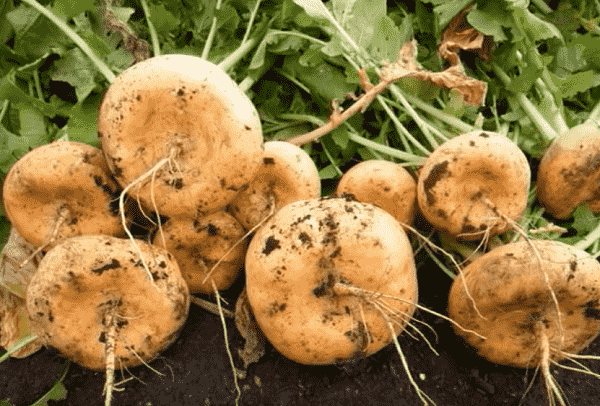

Turnip pests in the open field and control of them
The main pests of turnip in the initial period of its growing season are
- cruciferous fleas,
- cabbage butterfly,
- spring and summer cabbage fly,
- scoops,
- wireworms or clickers,
- stem nematode.
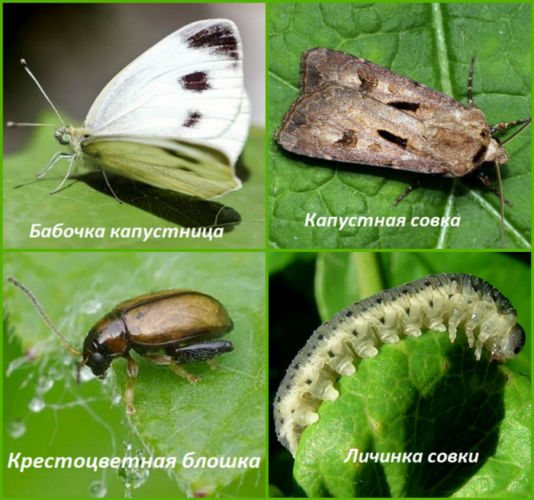

Under favorable conditions, pests can destroy all plantings and you will not wait for the harvest. The most effective way to prevent the appearance of pests on turnip plantings is preventive action. To this end, in advance
- They dig up the soil in early spring so that the larvae of pests that hibernated in the ground die in it;
- Prevent the growth of weeds that attract cabbage and scoop;
- When applying organic fertilizers to the soil, pest larvae can also be introduced at the same time, therefore, it is recommended to apply organic fertilizers in the fall, and in the spring, if necessary, apply mineral fertilizers;
- Plants with a pungent odor are well repelled by insect pests. Therefore, plant marigolds, celery, calendula, wormwood along the plantings;
- The most effective way at the initial stage is to cover the landings with a light non-woven material. You can also cover the aisles of plantings with wood chips or cover with dark spunbond.
You can cope with pests by manually removing the caterpillars, attracting birds that eat insects, or using solutions of chemical or folk remedies.
When applying chemical insecticides (Inta-vir, Karbofos, etc.), remember that the treatment with these drugs is carried out no later than 1 month before harvesting. Therefore, use the best folk methods.
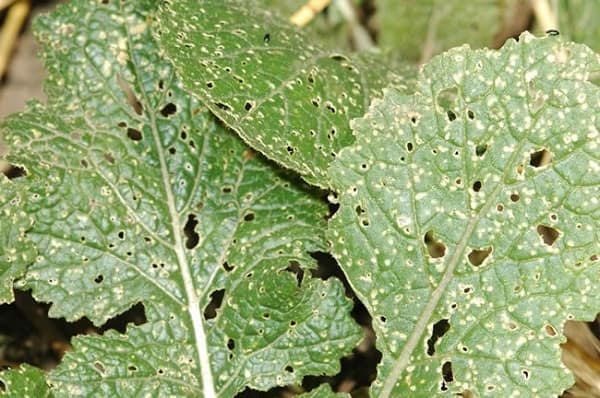

- Green soap diluted with water and sprayed with planting root crops.
- Infusion of pepper... 1 tbsp. l. red hot ground pepper is added to 1 liter of water, let it brew. Then the plantings are sprayed with a strong solution.
- Tobacco infusion... 100 g of makhorka is poured into 5 liters of water, let it brew, filter and spray the plants with infusion.
- Vinegar solution... 1 glass of vinegar is diluted in 1 bucket of water and sprinkled with turnips.
- Ash... Sifted dry wood ash is sprinkled on the leaves. It is better to carry out this in dry and calm weather. After rain, the procedure is repeated.
How to grow a turnip in the country (distance between plants)
Before planting seeds, we do not fertilize the soil, usually it is prepared in the fall.
On the prepared bed, we make grooves along or across the bed. The grooves are made at a distance of 20-25 cm from each other. They can be drawn with a flat cutter, a small spatula, or simply with the edge of the palm.The depth of the groove is no more than 2 cm.
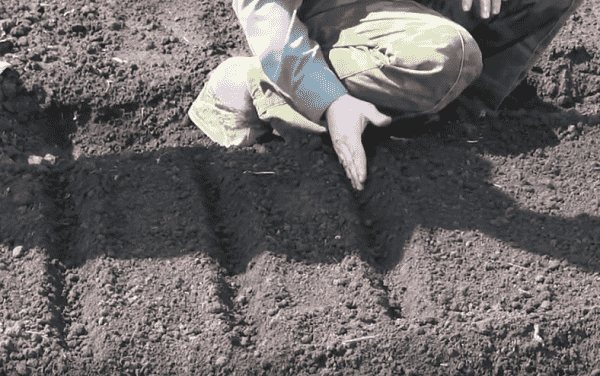

We moisten the grooves, pour water from a watering can so that the seeds immediately receive moisture. Pour the seeds onto the palm, a white sheet of paper, bent in half, or put them in a special seeder for small seeds. And we sow seeds, trying to distribute them as seldom as possible. But with small seeds it can be difficult to do this, so be prepared for the fact that the plantings will have to be thinned out. In order not to thicken the planting, small seeds can be mixed with inert substances (sand, chalk). By spreading a mixture of seeds and sand, it is easier to achieve an even distribution of seeds in the furrow.
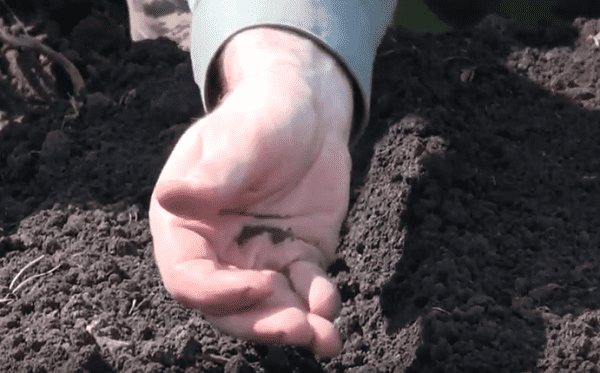

The crops are covered with earth from the edges of the groove and again the plantings are watered from a watering can.


For the appearance of friendly and fast planting shoots, we close the top with a light covering material. They will protect delicate seedlings from cruciferous flea beetles, prevent them from drying out and overheating. From personal experience, I do not recommend covering the plantings with a film, because it must be removed immediately after the emergence of seedlings, and it is at this time that the plants begin to attack the pests.
Fertilizers and feeding
If you sow your turnips in properly prepared soil, you can do without top dressing, or they should be extremely moderate.
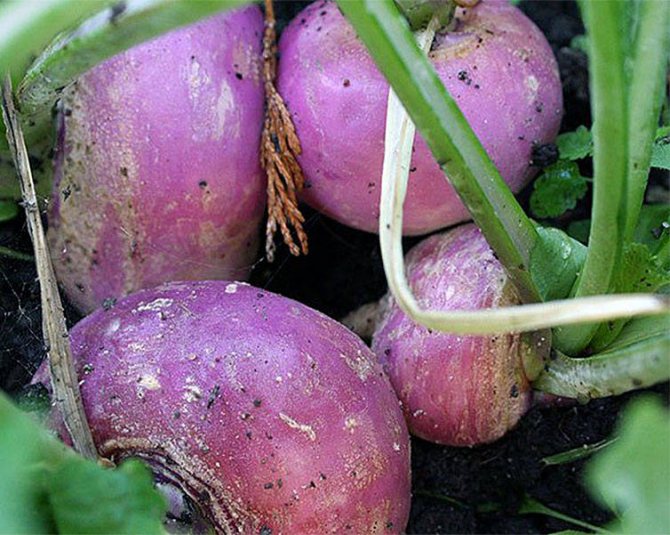

Use mineral fertilizers with caution - they accumulate in root crops.
It is best to use biologics.
Specifically for turnips, specialized fertilizers have not been developed, so any formulations for root crops, for example, such as BioHumus, Sapropel, Zdraven-aqua, Vermicompost, are suitable.
If the soil in the bed is too limed, use boric acid as a top dressing.
They help to increase the yield, increase the sugar content and keeping the turnip alive. Such support is very important in hot, dry summers.
Dissolve 2 grams of boric acid in a bucket of water and spray the tops after thinning.
Late
Late species include those whose ripening period is usually 90 days or more. Many of them in their gustatory characteristics are not inferior to the early ones, even surpass them.
Comet
The name was promoted by the specific elongated shape of the rhizome with a thickened part at the bottom. In addition, the Comet has excellent characteristics that match from fruit to fruit: weight, size and taste. The average ripening period is 80 days, the weight of one turnip is up to 120 grams.
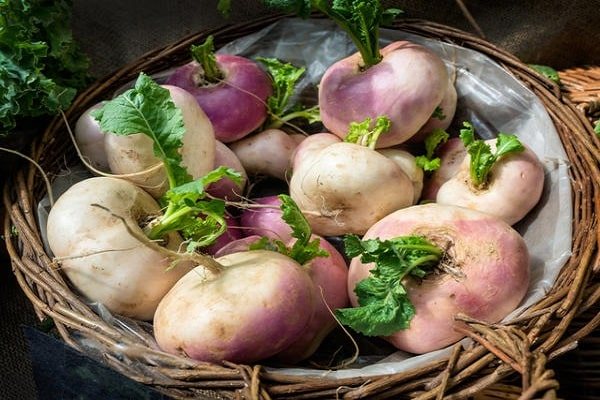

Orbit
This variety can be recognized by its regular spherical root crops, which ripen in 4 months. The turnip is large, white, the weight of one fruit reaches 500 grams. A very tasty look, which partly compensates for the ripening duration. Well tolerates storage in a cellar or basement in the winter.
What kind of turnip vegetable?
The benefits of turnip are priceless. Today it can be rarely found on the menu and completely in vain, because it is considered a medicinal plant. It can be used to prepare salads, soups, bake and stuff it. Turnip has antiseptic, pain relieving, wound healing properties. With its help, inflammatory processes can be stopped. The vegetable is indicated for those who have problems with appetite, it is enough to eat a slice of turnip and the feeling of hunger will immediately make itself felt. Eating some turnips for breakfast, lunch and dinner will speed up the digestion process.
Useful properties of turnip
Few know that the culture contains glucoraphanin. Such a trace element is considered very rare and has unique properties: it prevents the appearance of cancer cells in the human body, and also neutralizes existing ones!
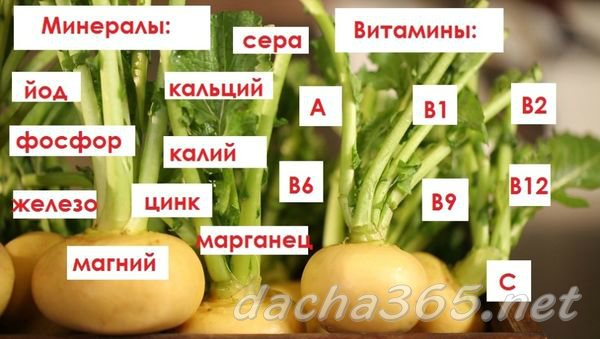

200 grams of turnips contains the daily requirement:
- vitamins A, C, B.
- useful substances such as potassium, calcium, sodium.
The fruits of the culture are low-calorie (there are 6.6 grams of carbohydrates per 100 grams).
The vegetable is considered to be useful for people who have diabetes mellitus, as well as for those who follow a healthy diet.

